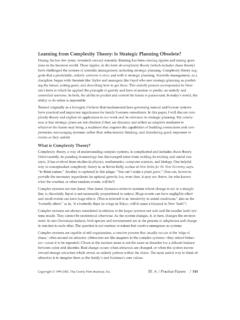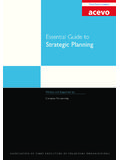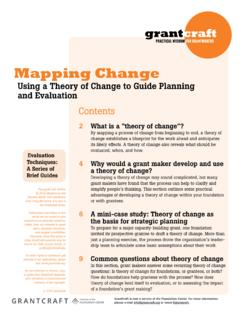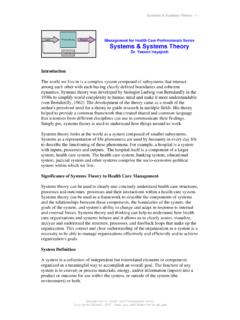Transcription of COMPLEXITY – CONSTRUCTION IN A NEW PERSPECTIVE
1 COMPLEXITY CONSTRUCTION IN A NEW PERSPECTIVE Sven Bertelsen1 ABSTRACT The general view of the CONSTRUCTION process is that it is an ordered, linear phenomenon, which can be organized, planned and managed top down. The frequent failures to complete CONSTRUCTION projects on budget and schedule give rise to a thinking that the process maybe not is as ordered and predictable in its nature as it may look. A closer examination reveals that CONSTRUCTION is indeed a complex, nonlinear and dynamic phenomenon, which often ex-ists on the edge of chaos. The paper introduces the world of complex systems and examines CONSTRUCTION in this PERSPECTIVE , and by that it proposes several new elements to the understanding of project KEY WORDS CONSTRUCTION , COMPLEXITY , project management 1 consulting engineer.
2 Sven Bertelsen, Strategic Counselor aps. Senior Research Advisor to Lean CONSTRUCTION Denmark. 2 The paper is a revised version of a report originally prepared as a contribution for an IGLC championship. It was accepted for the 2002 conference in Gramado, Brazil but was not presented or included in the proceedings. INTRODUCTION CONSTRUCTION projects are in general rich in plan failure, delays, cost overruns and grief; in-deed, more so than in successes. A general statement would be that the reason for this is the poor standard of project management. And the critics may be right.
3 But not in the way they think. In order to manage properly, one has to understand the nature of the system to be man-aged. And it seems that we have not as yet a proper understanding of the nature of the pro-jects we through project management try to manage. As Lucas (2000b) states: We have a considerable bias towards simplification and in many situations will reduce a complex multi-dimensional issue to a one-dimensional form more conducive to an either/or decision. Koskela and Howell (2002) deal with our perception of project management in great de-tail, and in a careful analysis challenge the lack of a firm theory for the understanding of the project.
4 This paper challenges the foundation for project management as well, but from an-other point of view, and it proposes at the same time a complete new hypothesis for the un-derstanding of the CONSTRUCTION process and thus for the nature of project management. The hypothesis proposed is that CONSTRUCTION along with most phenomena in our living world must be perceived as a complex system, operating on the edge of chaos. This under-standing forces project management to leave the traditional approach to its task, which is looking at the project as an ordered phenomenon expressed as management-as-planning and the associated top down approach to the leadership and enter the new world of self-organization and co-operation.
5 The paper starts with a brief introduction to the world of complex systems. The resent history in the understanding of such systems is outlined, and terms like dynamic, non-linear, self organized criticality and chaos are introduced as a framework for the understanding of the nature of complex systems and of their behavior. Next, CONSTRUCTION is looked at as a complex phenomenon and it is shown that CONSTRUCTION is indeed very complex, non-linear and dynamic, not only seen by the individual project but from an industry and a social per-spective as well. From this, the view moves to the behavior of complex systems and how to manage them where some general principles are introduced and brought into the framework of CONSTRUCTION in the form of a proposal for a new kind of project management.
6 Finally some examples of this new form of project management thinking are presented and discussed. Several authors have looked at project management from the complex systems point of view. However, often these authors use a specific angle. Williams (1999) characterizes com-plexity as structural uncertainty and uncertainty in goals and methods only, whereas Wild (2002) looks at the social system in projects. These authors usually use COMPLEXITY as a gen-eral characteristic of projects without applying the complex systems theory to their studies. Gidado (1996) as well as Kim and Wilemon (2003) even take an ordered approach to assess COMPLEXITY in projects.
7 Jenner (1998) proposes that lean organizations are successful because their fundamental structure embodies many of the characteristics of complex systems such as self-organization, and balance between order and chaos, an argument highly relevant to lean project manage-ment as well. The principles outlined in the paper are made with building projects in mind primarily. However, they will probably work just as well in any kind of CONSTRUCTION . They may also work in other kinds of projects such as development of computer programs or the making of movies. Even though the author has some experiences within both areas, it is not tried to stretch the principles any further than CONSTRUCTION .
8 Other kinds of projects may be more dif-ferent than they seem when dealing with the way we organize and manage the cooperation. And it is all about cooperation! COMPLEXITY A NEW WAY OF UNDERSTANDING NATURE We have all been brought up with Isaac Newton's understanding of the world. The almanac showed us when it was Easter and when the moon's eclipses took place, and our teachers in school told us that the way an apple falls down from the tree and the behavior of the planets are predictable phenomena. And we believed them. All phenomena in nature seemed to be predictable if only we reduced them to their basics and put them into proper formulas.
9 Later we found out that maybe not everything was so simple. Some phenomena were more complex, and they did not behave in accordance with our nice and linear formulas. There seemed to be something more to nature than Newton and Galileo had taught us. In-deed, when we looked closer we found that most of the world was not mechanistic and guided by simple cause and effect. You believe in a God who plays dice, and I in complete law and order. Einstein in a letter to Max Born on the interpretation of quantum mechanics It started around 1900 with the emergence of the quantum mechanics, which challenged Al-bert Einstein to the above statement because of the need for dealing with the systems in a purely statistical way.
10 A shock for the established scientific society who then believed that physics now knew almost everything about the world with a few, minor details missing only. The work of Niels Bohr taught them at the same time that the observer and the observed ob-ject are not independent they interact, and the observed system can thus not be considered as ordered in its own right. The act of observing it disturbs the order the system might have possessed before the observation. Later came the world of complex systems, which can be said to lie between the ordered Cartesian world and the statistical world of quantum mechanics. Today it is more and more recognized that most systems in our surroundings are not linear and ordered but non-linear, complex and dynamic.







